|
|
Website Link Index | |||||||
|
Son of Orson Pratt Brown and Martha Diana Romney Brown:
|
FAMILY HISTORY OF RAY BROWN I
|
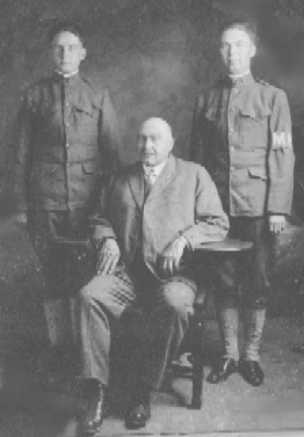 |
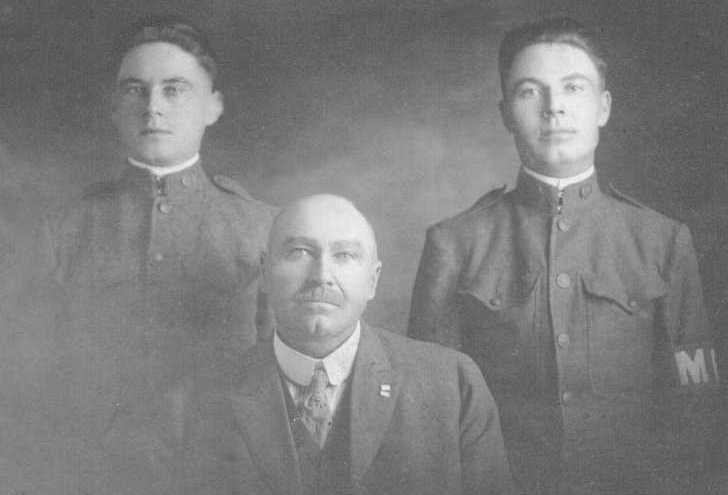 Miles Romney Brown Orson Pratt Brown Ray Brown Left-bottom corner: Miles and Ray Brown, between 1913-1917 |
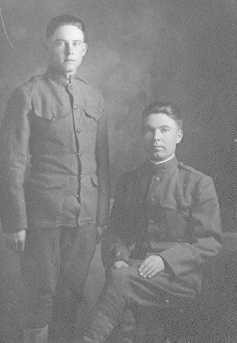 |
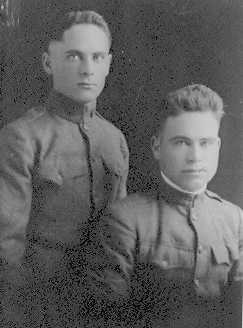 |
[After the thing was over and Pershing had gone, the Carranza government had offered Villa amnesty and he accepted it. They gave him that big Canutillo ranch. After Villa was settled and peaceful, Ray went down to sell him some agricultural machinery and he asked Villa; "General, when you came to Dublan that night when you were on the retreat from Columbus, why did you go out around?" Villa said, "I saw all those camp fires in the streets, and I was in no shape to fight." That night the graveyard fence, which was made of pine lumber and cedar posts five boards high, burned down, and from the reflection on this glass, he thought there was an army in here. He said, "I saw all those fires." Harvey Hyrum Taylor investigated this phenomenon from different locations and found that the graveyard fence fires were likely reflecting on the various home windows causing it to appear from a distance that there were campfires throughout the town. Story found in the Life and Times of Harvey Hyrum Taylor, Page 48, 101.]
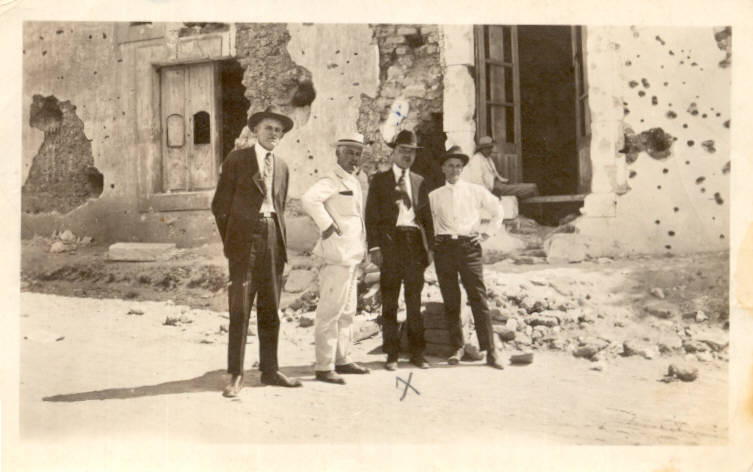
X = Ray Brown with friends in front of bullet-ridden wall in Chihuahua after Revolution.
Ray was 20 years old when Exodus occurred in 1912.
After the war my grandparents were married in El Paso, Texas, and then moved to Mexico. My father was born in Chihuahua on August 4th, 1921. During the early 1920's my grandfather was in the car business, until one individual approached him with some minerals that were found in the Namiquipa area in the State of Chihuahua. After the ore was assayed, a significant content of gold was discovered. From that time on my grandfather then moved to Namiquipa in order to promote and develop the mine. In the beginning the financial aspect of the venture was challenging, he even had to close down the mine during the depression. He moved to El Paso, Texas for a while until he secured additional financing to re-open the mine. All of them lived in Namiquipa until they bought their property in Nombre De Dios, sometimes during the 1930's. This was a small agricultural town a few miles north of Chihuahua City. This is were I grew up until I was sixteen, the house was built by French industrialists in the 1880's, it was Victorian style and was converted into a hospital for revolutionaries under Pancho Villa. On these grounds, my grandfather, Ray Brown, enjoyed cultivating his apple and pecan orchards during his last years. The property was sold when we moved back up to El Paso during 1959.
During the late 1930's my grandfather achieved financial success in the mining business primarily by buying and selling mining leases. One interesting mining lease was Plomosas located near Ojinaga, which is a border town in the Texas Big Bend country. According to my father, the Plomosas mine was hundreds of years old, and was originally worked by the Spaniards. In those early mining days of the 17th century the engineering techniques they would use can still be seen to this day. To hold the ceiling of the interior of the mine, the Spaniards would mine large entrances and would leave large pillars for support. They would also use black powder to extract the ore. This particular mine was a lead and zinc mine with substantial deposits of galena ore. My grandfather simply mined the pillars and turned the property into a successful mining operation until he sold the lease to ASARCO, (American Smelting and Refining Co. operates a smelter for lead and zinc outside the city limits of Chihuahua, where the airport is now located).
Page 3
During these (the late 1930's and early 40's) years, Dewey Brown maintained the financial and accounting records, and Clyde Brown assisted my grandfather in the operation of the various mines. Clyde Brown bought his property next to where we lived, my mother would tell me she had fun times with Aunt Mabel (one incident often mentioned was when they both packed lingerie in Aaron Brown's suit case while on his way to a mission). Manuela, Uncle Clyde's housekeeper, remembers hearing his 45 cal. Auto being discharged at the front gate when she delayed to open it. He would later operate mines with my father.
All of the Brown's business was conducted out of their office located in downtown Chihuahua City. Their social affairs included daily meetings with outside visitors who would stay at the Hotel Victoria (a colonial style hotel located in Chihuahua City).
My grandfather's best friend was Skeet Williams who owned a ranch in between Chihuahua and El Paso. Skeet was a legend in West Texas since he was one of last of the old time cowboys, he also attended my wedding at the Ft. Bliss Officers Club in El Paso on December 22nd 1971.
My grandfather's other best friend who sometimes played a significant role was Guillermo Quevedo the [brother of] Governor of Chihuahua during the 1930's, General Rodrigo Quevedo Moreno (1888-1967). During the early 1930's, President Calles with his communist influence decided to close all religious institutions. At risk were all Catholic and Protestant churches in the Chihuahua City area; this situation also included the LDS Ward. The church officials from various denominations including the LDS church approached my grandfather to negotiate a settlement with the authorities. Apparently General Quevedo interceded, since all of the churches remained open during those perilous times. The following is one among many anecdotes related by my father. [Clyde] Glen Brown (1917-1944) was riding in the same vehicle that General Quevedo's brother was driving. The incident occurred during a political campaign in Chihuahua City in the early 1940's. They were parked alongside a well-known street when suddenly the brother was approached with a drawn 45 cal. Auto. Fortunately for Glen, the General's brother reacted swiftly, with one hand he pushed back the slide immediately blocking the hammer mechanism, and with the other he drew his 45 cal. Auto and discharged it four times in the opponents lower side.
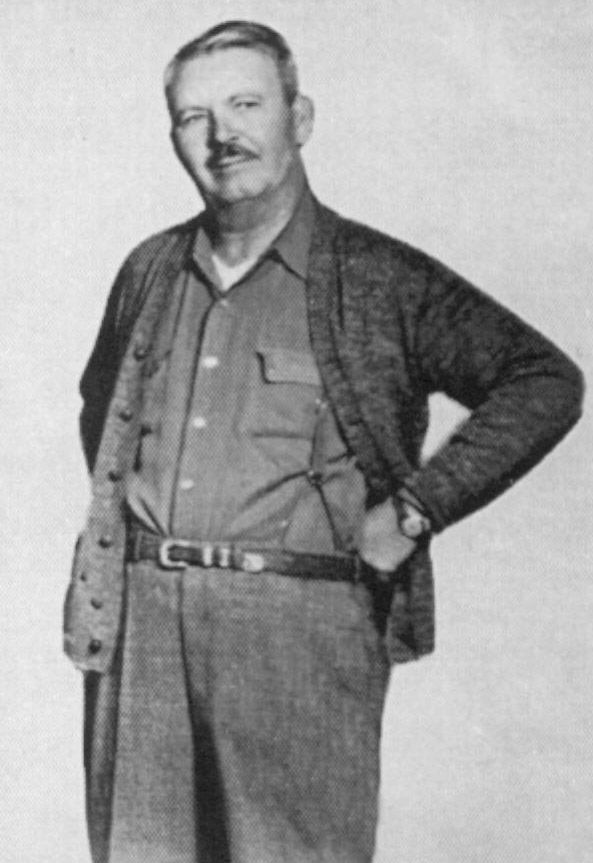
Ray Brown I, age 50
The mining leases were sold and a distribution was made to Dewey and Clyde who invested some of the proceeds in Caterpillar dealerships. My grandfather, Dewey, Clyde, and Eloy Vallina (who owned the Banco Commercial de Chihuahua and was assassinated inside his own bank lobby during the early 1960's) founded Maquinaria General de Chihuahua S.A., all owned equal shares. The Caterpillar Corporation sold the franchise to "Maquinaria" granting exclusive territorial rights for the States of Chihuahua, Sonora, Sinaloa, and Coahuila. Dewey operated the dealerships in the coastal towns of Hermosillo, Cd. Obregon, and Culiancan, my grandfather and Clyde operated the dealerships in the State of Chihuahua, and Coahuila. All of this took place during the early 1940's, my father at this time was attending New Mexico Military Institute, and Glen was at the College of Mines in El Paso. Glen was commissioned and achieved the rank of captain, as a B-26 Marauder pilot (known as the widow maker), he was killed in action sometimes during the Battle of the Bulge in December of 1944. My father who was an infantry 1st Lt. in the 99th Division, was reported as missing in action during the same battle and at the same period of time. My father did not return from WWII until after my grandfather's death.
All of the above events must had an impact on my grandfather's health, he suffered extreme pain in his face due to a virus related to chickenpox (shingles). My grandparents traveled to the Mayo Clinic in New York, and the resulting surgery did relieve the pain, however; it was short lived. On October 11, 1945, my grandfather passed away on the operating table in New Orleans, LA. Again the purpose of the operation was to sever nerve endings in order to relieve the pain from the virus. The doctor that put him under had applied excessive chloroform.
Page 4
Elsie Johnson Anderson [Amy Brown's sister who was 98 when she died December 15, 2003], who resides in Salt Lake City remembers the long funeral procession from El Paso to Chihuahua. She also has fond memories of my grandfather, in particular his generosity, good sense of humor, and being well liked by all. My Aunt Elsie also knew Martha Diana in Rupert while she was a child. Aunt Elsie's mother Pauline Johnson and Martha Diana were good friends. Elsie also remembers the viewing, which lasted three days. It is well known that in Mexico the majority of people in those times did not share the same material resources as those living on this side of the border. However; it is these people that attended the funeral and truly expressed their sorrow. There are many anecdotes relating to my grandfather, I will just mention a few. Manuela once told me the story of a man on horseback that approached her while she was attending a flock of turkeys on her farm. The man asked if she would sell him some birds, Manuela responded (not realizing that the man on horseback was my grandfather), that she was saving her turkeys for the rich gringo down the road, and that he would pay a higher price. My grandfather and my father with their olive skin would blend in with the population since they both wore a mustache and also the local hats. I came across Tony Vega in a shopping mall in El Paso during the 1980's, again my grandfather was mentioned in the ensuing conversation. Tony Vega bought uncle Clyde's house and was our neighbor; his father was a general in the revolution. Mr. Vega then related the story of when my grandfather was being held in a prison by the revolutionary forces under charges for spying. General Vega knew my grandfather in the Colonies and played a role in releasing my grandfather by identifying him as not being the right man, but just another gringo.
While growing up in Chihuahua I would run across people who knew my grandfather. The night custodian at my school knew my grandfather and shared fond memories. Others in Nombre De Dios would also relate stories, in particular how my grandfather would always distribute candy to all of the children in the small town on the Mexican holiday known as "El dia de los ninos" (children's day). My grandfather was remembered primarily by the local people as being a very friendly and generous man, which in my estimation is his finest tribute.
Sources:
PAF - Archer Files = Orson Pratt Brown + Martha Diana Romney > Ray Brown
Biographical story contributed to this site by Ray Brown III.
Bertha's Book of Remembrance
Photo identification by James Gordon Brown.
Clarification on Guillermo Quevedo from Erin L. Quevedo T. of Casas Grandes, Chih., Mx. <elquevedo@miners.utep.edu>
Life and Times of Harvey Hyrum Taylor, Page 48, 101
Copyright 2001 www.OrsonPrattBrown.org
![]()
To SEARCH THIS SITE: Use the Google.com search engine
Type....site:OrsonPrattBrown.org "TYPE NAME YOU ARE
LOOKING FOR INSIDE PARENTHESIS"...Press ENTER
A list with the search term will appear.
![]() OPB FAMILY BLOG SITE
OPB FAMILY BLOG SITE
... http://orsonprattbrownfamily.blogspot.com/
![]() PERSONAL ANCESTRAL FILE
PERSONAL ANCESTRAL FILE
... Password Access Only
![]() ADDRESS LIST FOR BROWN FAMILY
ADDRESS LIST FOR BROWN FAMILY
... Password Access Only
![]() ORSON PRATT BROWN FAMILY REUNIONS
ORSON PRATT BROWN FAMILY REUNIONS
... Easter 1986 through October 2005
... ARTICLES OF ASSOCIATION - BY-LAWS
COMMENTS AND INPUT ON ARTICLES
... Published December 2007:
![]() "ORSON PRATT BROWN AND HIS FIVE WONDERFUL WIVES VOL. I and II"
"ORSON PRATT BROWN AND HIS FIVE WONDERFUL WIVES VOL. I and II"
![]() By Erold C. Wiscombe
By Erold C. Wiscombe
... Published March 2009:
![]() "CAPTAIN JAMES BROWN AND HIS 13 WIVES"
"CAPTAIN JAMES BROWN AND HIS 13 WIVES"
(unfortunately the publisher incorrectly changed the photo
and spelling of Phebe Abbott Brown Fife's name
after it was proofed by this author)
Researched and Compiled by Erold C. Wiscombe
... Published 2012:
"Finding Refuge in El Paso"
By Fred E. Woods [ISBN: 978-1-4621-1153-4]
Includes O.P Brown's activities as Special Church Agent in El Paso
and the Juarez Stake Relief Committee Minutes of 1912.
...Published 2012:
"Colonia Morelos: Un ejemplo de ética mormona
junto al río Bavispe (1900-1912)"
By Irene Ríos Figueroa [ISBN: 978-607-7775-27-0]
Includes O.P. Brown's works as Bishop of Morelos. Written in Spanish.
...Published 2014:
"The Diaries of Anthony W. Ivins 1875 - 1932"
By Elizabeth Oberdick Anderson [ISBN: 978-156085-226-1]
Mentions O.P. Brown more than 30 times as Ivins' companion.
... To be Published Soon:
![]() "CAPTAIN JAMES BROWN 1801-1863:
"CAPTAIN JAMES BROWN 1801-1863:
![]() TEMPER BY NATURE, TEMPERED BY FAITH"
TEMPER BY NATURE, TEMPERED BY FAITH"
![]() Send Comments and Information to:
Send Comments and Information to:
![]() OrsonPrattBrown@gmail.com
OrsonPrattBrown@gmail.com
... FAMILY GROUP PHOTOS
... FAMILY REUNIONS
... Lily Gonzalez Brown 80th Birthday Party-Reunion
![]() July 14, 2007 in American Fork, Utah
July 14, 2007 in American Fork, Utah
...Gustavo Brown Family Reunion in October 2007
... FAMILY MEMBERS WHO DIED RECENTLY
... NEWS, WEDDINGS, BABIES, MORE
... HELP US IDENTIFY THESE ANCESTORS
![]() Send Additions and Information to:
Send Additions and Information to:
![]() OrsonPrattBrown@gmail.com
OrsonPrattBrown@gmail.com
...... Wives and 35 Children Photo Chart
...... Chronology
...... Photo Gallery of OPB
...... Letters
...... Biographical Sketch of the Life Orson Pratt Brown
...... History of Orson Pratt Brown by Orson P. Brown
...... Journal & Reminiscences of Capt. Orson P. Brown
...... Memories of Orson P. Brown by C. Weiler Brown
...... Orson Pratt Brown by "Hattie" Critchlow Jensen
...... Orson Pratt Brown by Nelle Spilsbury Hatch
...... Orson Pratt Brown by W. Ayrd Macdonald
...... Wives and 29 / 43 Children Photo Chart
...... Captain James Brown's Letters & Journal
...... Brown Family Memorabilia
...... Mormon Battalion 1846-1847
...... Brown's Fort ~ then Brownsville, Utah
...... Chronology of Captain James Brown
- James Brown of Rowan County, N.C. 1757-1823
- Mary Williams of Rowan County, N.C. 1760-1832
- Stephen Joseph Abbott of, PA 1804-1843
- Abigail Smith of Williamson, N.Y. 1806-1889
- John Fife of Tulliallan, Scotland 1807-1874
- Mary Meek Nicol, Carseridge, Scotland 1809-1850
- Martha "Mattie" Diana Romney Brown 1870-1943
![]()
![]()
![]()
- Jane "Jennie" Bodily Galbraith Brown 1879-1944
![]()
![]()
- Elizabeth Graham MacDonald Webb Brown 1874-1904
- Eliza Skousen Brown Abbott Burk 1882-1958
- Angela Maria Gavaldón Brown 1919-1967
![]()
- (Martha) Carrie Brown (child) 1888-1890
- (Martha) Orson Pratt Brown, Jr. (child) 1890-1892
- (Martha) Ray Romney Brown 1892-1945
- (Martha) Clyde Romney Brown 1893-1948
- (Martha) Miles Romney Brown 1897-1974
- (Martha) Dewey B. Brown 1898-1954
- (Martha) Vera Brown Foster Liddell Ray 1901-1975
- (Martha) Anthony Morelos Brown 1904-1970
- (Martha) Phoebe Brown Chido Gardiner 1906-1973
- (Martha) Orson Juarez Brown 1908-1981
- (Jane) Ronald Galbraith Brown 1898-1969
- (Jane) Grant "Duke" Galbraith Brown 1899-1992
- (Jane) Martha Elizabeth Brown Leach Moore 1901-1972
- (Jane) Pratt Orson Galbraith Brown 1905-1960
- (Jane) William Galbraith Brown (child) 1905-1912
- (Jane) Thomas Patrick Porfirio Diaz Brown 1907-1978
- (Jane) Emma Jean Galbraith Brown Hamilton 1909-1980
- (Elizabeth) (New born female) Webb 1893-1893
- (Elizabeth) Elizabeth Webb Brown Jones 1895-1982
- (Elizabeth) Marguerite Webb Brown Shill 1897-1991
- (Elizabeth) Donald MacDonald Brown 1902-1971
- (Elizabeth) James Duncan Brown 1904-1943
- (Eliza) Gwen Skousen Brown Erickson Klein 1903-1991
- (Eliza) Anna Skousen Brown Petrie Encke 1905-2001
- (Eliza) Otis Pratt Skousen Brown 1907-1987
- (Eliza) Orson Erastus Skousen Brown (infant) 1909-1910
- (Eliza) Francisco Madera Skousen Brown 1911-1912
- (Eliza) Elizabeth Skousen Brown Howell 1914-1999
- (Angela) Silvestre Gustavo Brown 1919-
- (Angela) Bertha Erma Elizabeth Brown 1922-1979
- (Angela) Pauly Gabaldón Brown 1924-1998
- (Angela) Aaron Aron Saul Brown 1925
- (Angela) Mary Angela Brown Hayden Green 1927
- (Angela) Heber Jedediah Brown (infant) 1936-1936
- (Angela) Martha Gabaldón Brown Gardner 1940
- Stephen Abbott Brown 1851-1853
- Phoebe Adelaide Brown Snyder 1855-1930
- Cynthia Abigail Fife Layton 1867-1943
- (New born female) Fife 1870-1870
- (Toddler female) Fife 1871-1872
- (Martha Stephens) John Martin Brown 1824-1888
- (Martha Stephens) Alexander Brown 1826-1910
- (Martha Stephens) Jesse Stowell Brown 1828-1905
- (Martha Stephens) Nancy Brown Davis Sanford 1830-1895
- (Martha Stephens) Daniel Brown 1832-1864
- (Martha Stephens) James Moorhead Brown 1834-1924
- (Martha Stephens) William Brown 1836-1904
- (Martha Stephens) Benjamin Franklin Brown 1838-1863
- (Martha Stephens) Moroni Brown 1838-1916
- (Susan Foutz) Alma Foutz Brown (infant) 1842-1842
- (Esther Jones) August Brown (infant) 1843-1843
- (Esther Jones) Augusta Brown (infant) 1843-1843
- (Esther Jones) Amasa Lyman Brown (infant) 1845-1845
- (Esther Jones) Alice D. Brown Leech 1846-1865
- (Esther Jones) Esther Ellen Brown Dee 1849-1893
- (Sarah Steadwell) James Harvey Brown 1846-1912
- (Mary McRee) George David Black 1841-1913
- (Mary McRee) Mary Eliza Brown Critchlow1847-1903
- (Mary McRee) Margaret Brown 1849-1855
- (Mary McRee) Mary Brown Edwards Leonard 1852-1930
- (Mary McRee) Joseph Smith Brown 1856-1903
- (Mary McRee) Josephine Vilate Brown Newman 1858-1917
- (Phebe Abbott) Stephen Abbott Brown (child) 1851-1853
- (Phebe Abbott) Phoebe Adelaide Brown 1855-1930
- (Cecelia Cornu) Charles David Brown 1856-1926
- (Cecelia Cornu) James Fredrick Brown 1859-1923
- (Lavinia Mitchell) Sarah Brown c. 1857-
- (Lavinia Mitchell) Augustus Hezekiah Brown c. 1859
- (Diane Davis) Sarah Jane Fife White 1855-1932
- (Diane Davis) William Wilson Fife 1857-1897
- (Diane Davis) Diana Fife Farr 1859-1904
- (Diane Davis) John Daniel Fife 1863-1944
- (Diane Davis) Walter Thompson Fife 1866-1827
- (Diane Davis) Agnes Ann "Aggie" Fife 1869-1891
- (Diane Davis ) Emma Fife (child) 1871-1874
- (Diane Davis) Robert Nicol Fife (infant) 1873-1874
- (Diane Davis) Barnard Fife (infant) 1881-1881
- (Cynthia Abbott) Mary Lucina Fife Hutchins 1868-1950
- (Cynthia Abbott) Child Fife (infant) 1869-1869
- (Cynthia Abbott) David Nicol Fife 1871-1924
- (Cynthia Abbott) Joseph Stephen Fife (child) 1873-1878
- (Cynthia Abbott) James Abbott Fife (infant) 1877-1878
- (Diana) Caroline Lambourne 18461979
- (Diana) Miles Park Romney 1843-1904
- (Jane) Emma Sarah Bodily 1858-1935
- (Jane) William Wilkie Galbraith 1838-1898
- (Elizabeth) Alexander F. Macdonald 1825-1903
- (Elizabeth) Elizabeth Atkinson 1841-1922
- (Eliza) Anne Kirstine Hansen 1845-1916
- (Eliza) James Niels Skousen 1828-1912
- (Angela) Maria Durán de Holguin 1876-1955
- (Angela) José Tomás Gabaldón 1874-1915
|
Contact Us: |